How cute are baby owls? These little balls of fluff hardly resemble the fierce predators they will one day become. But one day they will look just like their parents and become kings and queens of the night. Ornithologists currently recognize approximately 250 different species of owls, and these birds of prey live on every continent except Antarctica. Let’s take a look at a few adorable baby owls and learn some amazing facts about these species.
#1: Barn Owls Are the Most Widespread Owls in the World
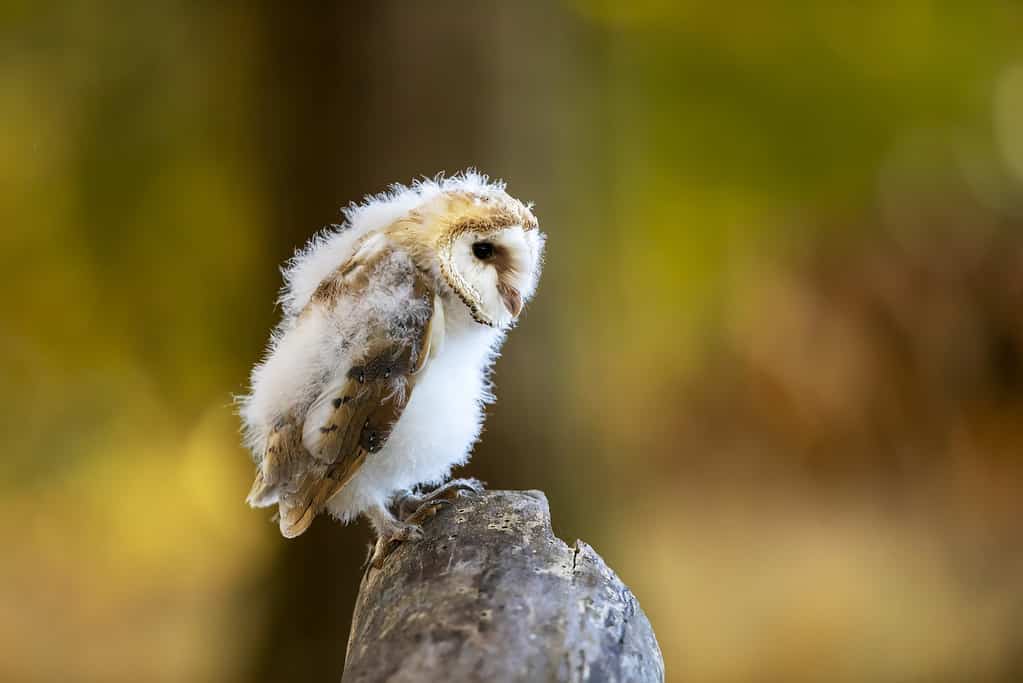
Barn Owls (
Tyto alba) have the most expansive range of any owls in the world.
©scigelova/iStock via Getty Images
The Barn Owl (Tyto alba), with its slender form and heart-shaped face, is the most widespread owl species in the world. Its range covers all of South and Central America, all of Mexico, most of the United States, and far southwestern Canada. Barn Owls also live throughout most of sub-Saharan Africa, far northern Africa, Madagascar, much of Europe, parts of the Middle East, India, and Asia south of the Himalayas, Australia, and many Pacific islands. Many owls have expansive distributions, but none compare with the Barn Owl. This species is named for its tendency to nest and raise baby owls in barn lofts. Look for owl pellets, regurgitated pellets filled with bones and fur, on the ground near barns or other structures as evidence of Barn Owls roosting above.
#2: Eurasian Eagle-Owls Are the Second Largest Owls in the World
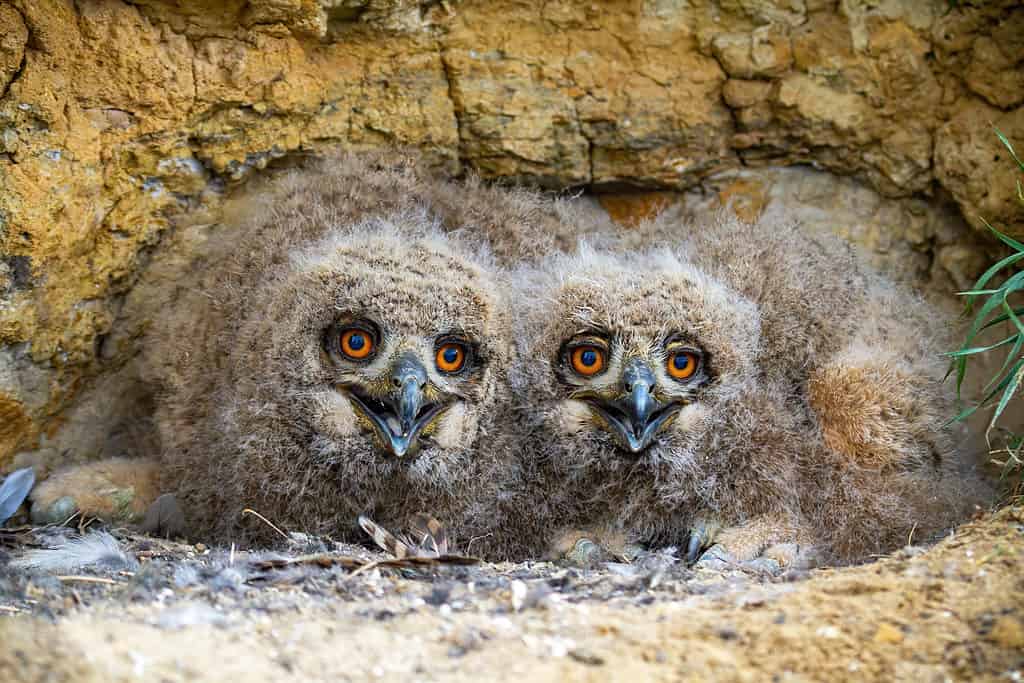
Eurasian Eagle-owls (
Bubo bubo) have striking orange eyes, even as hatchlings.
©WildMedia/Shutterstock.com
The Eurasian Eagle-owl (Bubo bubo) is the second largest owl in the world. The Eurasian Eagle-owl ranges over almost all of subarctic Europe and Asia, along with far northern Africa. These owls grow up to 30 inches in length and average close to 9 pounds, but some females have been recorded at more than 10 pounds. Their wingspan can reach up to 6 feet! Currently, 16 subspecies of Eurasian Eagle-owls exist, and the bright orange color of their eyes varies from one subspecies to the next. Even the baby owls have characteristically bright orange eyes.
#3: Snowy Owls Are the Largest Owls in North America
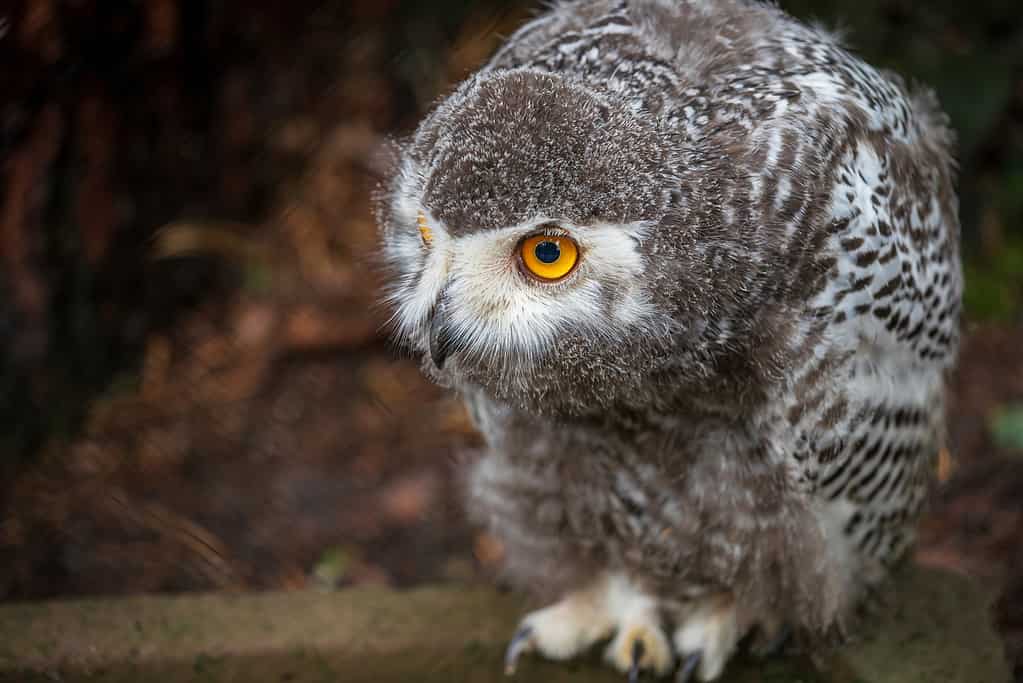
Snowy Owl (
Bubo scandiacus) nestlings do not have the mostly white plumage they will get when they are older.
©Vronja_Photon/iStock via Getty Images
The Snowy Owl (Bubo scandiacus), with its vibrant yellow eyes, is the largest owl species in North America. They weigh significantly less than Eurasian Eagle-owls, reaching about 4.5 pounds. However, they can reach lengths of more than 27 inches with wingspans measuring more than 4 feet. Snowy Owls range over North America, including Alaska and northern Canada, as well as Greenland, Iceland, and northern Europe and Asia. The species resides mainly in icy cold, Arctic regions during the summer, moving a little farther south in the winter. Baby owls of this species have mostly gray, heavily barred plumage. Their bars fade as they get older, and they turn whiter overall. Males generally have whiter feathers than females, which tend to retain brown or gray bars all their lives.
#4: Great Horned Owls Range over North and South America
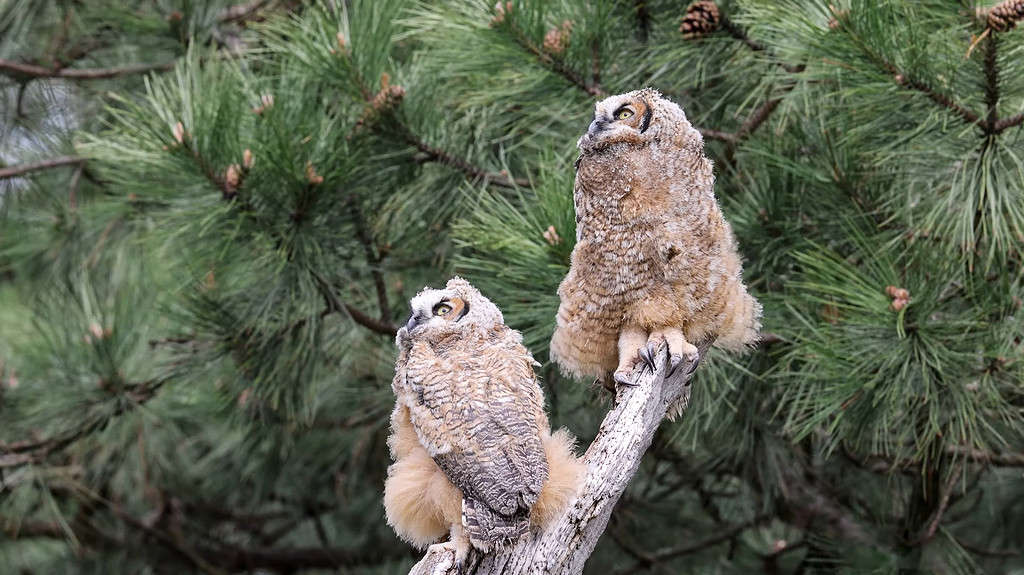
Fledgling Great Horned Owls (
Bubo virginianus) bear the striped markings of adults.
©Banu R/iStock via Getty Images
The Great Horned Owl (Bubo virginianus) has a range that covers most of North America, even into the Arctic region, and much of South America all the way to Argentina. This mighty owl is quite a bit smaller than the Eurasian Eagle-owl, but it fills the same ecological niche throughout most of the Americas. It is an apex predator that eats rabbits, rodents, lizards, other birds including birds of prey, domestic cats and small dogs, and anything else it can catch. Males deliver food nightly to the baby owls and the mother on the nest. The Great Horned Owl is named for the tufts of feathers on its head that look like horns. It also has a pattern of stripes on its feathers reminiscent of a tiger.
#5: Barred Owl Numbers Are Rising Dangerously Fast

Barred Owls (
Strix varia) are considered an invasive species through the western part of their range.
©Jim Cumming/Shutterstock.com
The Barred Owl (Strix varia) is an opportunistic species that has rapidly expanded both in numbers and in range. In the Pacific Northwest and into the Sierra Nevada region, Barred Owls have invaded the range of similarly sized Northern Spotted Owls. The Northern Spotted Owl was already facing pressure due to habitat degradation, and environmentalists have long urged the government to take action to protect them. Stopping the spread of Barred Owls outside their former range, which included most of the eastern United States and much of Canada, would be complicated and costly. Barred owls stick mainly to forested areas and raise their baby owls in large cavities in trees, nest boxes, abandoned nests of other species, or nests they build themselves.
#6: Screech Owls Range Over the Americas

Eastern Screech Owls (
Megascops asio) often nest inside holes in old trees.
©Carol Hamilton/iStock via Getty Images
Approximately two dozen different species of screech owls exist, and all of them live in North, South, or Central America. Most of the screech owl species live in South America, with several species having very limited ranges. Only two species live in the United States: Eastern Screech Owls (Megascops asio) and Western Screech Owls (Megascops kennicottii). Eastern Screech Owls range east of the Rocky Mountains, from far southern Canada to northern Mexico. Western Screech Owls cover the western portion of the United States, up the Canadian coast to Alaska, and much of Mexico. Screech owls are among the smallest owl species, reaching lengths of around 10 inches at most, and weighing roughly 6 ounces. They raise their babies in cavities in old trees.
#7: Burrowing Owls Raise Their Babies in Holes in the Ground
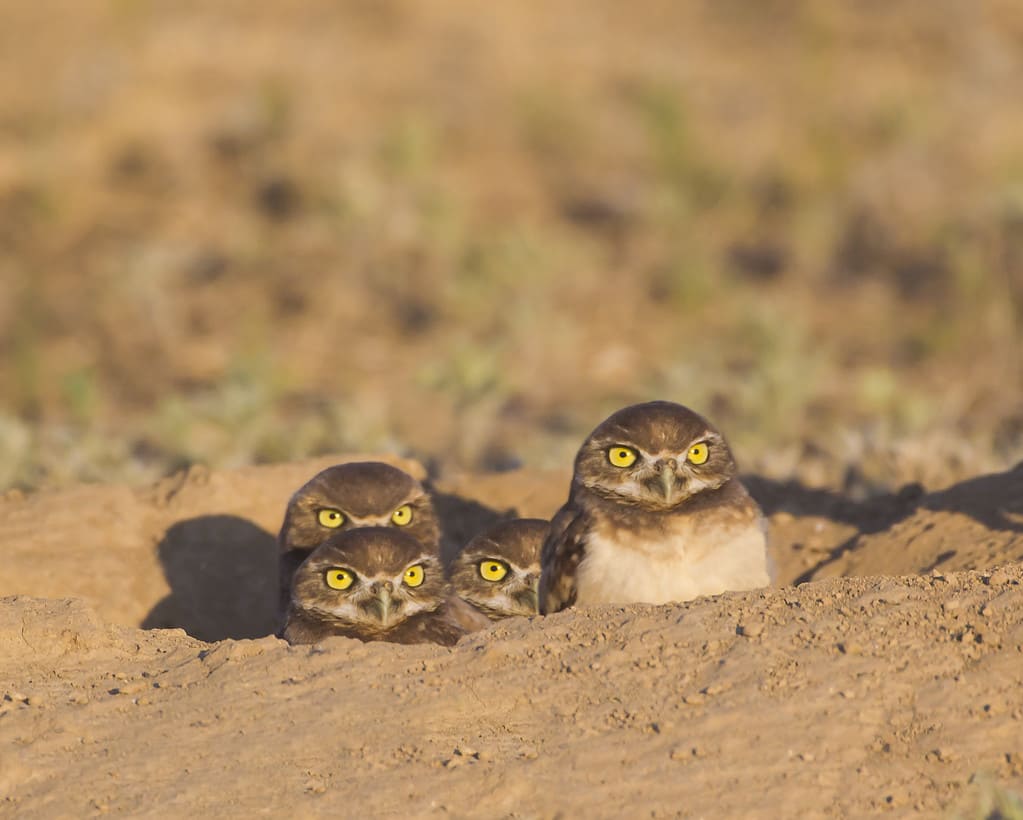
Burrowing Owls (
Athene cunicularia) nest in burrows under the ground.
©RichardSeeley/iStock via Getty Images
The Burrowing Owl (Athene cunicularia), native to the Americas, is not like most other owls. Burrowing Owls raise their babies in burrows in the ground, such as those abandoned by prairie dogs. These tiny owls only grow to about 11 inches in length and up to about 8 ounces. Their heads look quite flat, as compared with other owl species, and they often flip them over a full 90 degrees to look at things sideways. Unlike many owls that are primarily nocturnal, Burrowing Owls are typically crepuscular, hunting in the dawn and dusk hours. They also frequently come out of their burrows during the day, so if you happen to be in their vicinity, you have a decent chance of spotting one. Burrowing Owls also differ from many other owls in that some subspecies migrate from their northern breeding ranges to southern winter ranges.
#8: Tawny Owls Are Fierce Defenders of Their Young
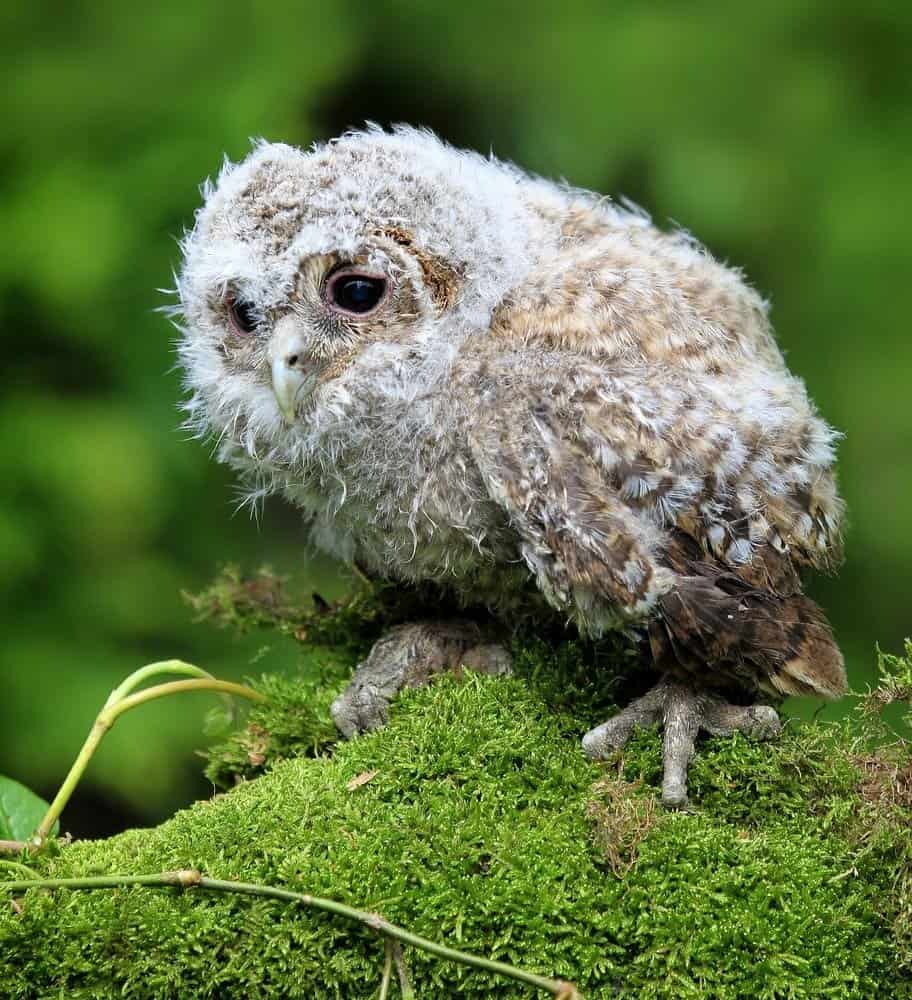
Tawny Owl (
Strix aluco) babies are super cute, but beware of their vicious parents.
©Mark Caunt/Shutterstock.com
When it comes to raising baby owls, the Tawny Owl (Strix aluco) is just about the fiercest defender of all. These vicious owls may not be among the largest Eurasian owls, but they will take on intruders of any size to defend their young. They attack by using their strong talons to rip and tear at the head of their foe. Tawny Owls, also known as Brown Owls, have reddish-brown to grayish-brown feathers, varying with the subspecies. Their underparts are lighter colored and streaked with brown or gray. Baby Tawny Owls are mostly gray with lighter markings around their face.
#9: The Largest Owl in the World Is Endangered
The largest owl in the world is the Blakiston’s Eagle-owl, also known as the Blakiston’s Fish Owl (Bubo blakistoni). This owl is closely related to the Eurasian Eagle-owl and just slightly larger. The Blakiston’s Eagle-owl has a narrow range, including a small part of Russia, China, and the cold, northern region of Hokkaido, Japan. It has an estimated population of fewer than 2,500 mature adult birds.
#10: The Smallest Owl in the World Can Fit in the Palm of Your Hand
The Elf Owl (Micrathene whitneyi) is the smallest owl in the world. It weighs just 1.4 ounces and reaches lengths up to 5.7 inches. For reference, that’s roughly the size of a Purple Finch. Elf Owls migrate back and forth from Mexico to the southwestern United States. They nest in abandoned woodpecker holes after removing any old nesting material.
The photo featured at the top of this post is © Vronja_Photon/iStock via Getty Images
Thank you for reading! Have some feedback for us? Contact the AZ Animals editorial team.






